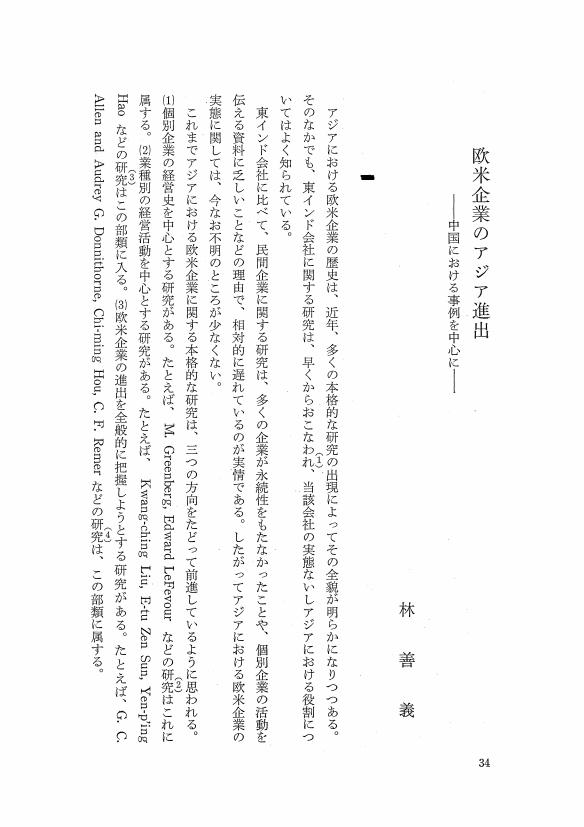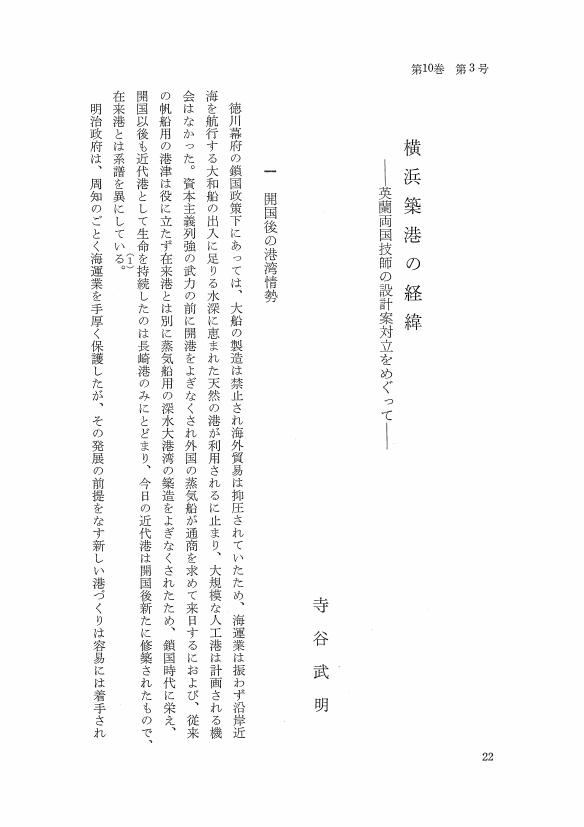- 著者
- 天川 潤次郎
- 出版者
- 経営史学会
- 雑誌
- 経営史学 (ISSN:03869113)
- 巻号頁・発行日
- vol.11, no.3, pp.1-25, 1977-03-15 (Released:2010-11-18)
The 'economic ethics' or 'business creeds' as evinced in Hunt's “Merchants' Magazine, and Commercial Review”, 51 vols. are so to speak the 'secularized Puritan ethics' themselves, considering from the fact that the editor and proprietor Freeman Hunt was called the 'worthy successor to B. Franklin' by I. G. Wyllie. The motives and causes of secularization of American Puritan ethics are these: the democratic influence derived from the French and American Revolutions, the humanizing influence from the Enlightenment, and the religious influences from the Greating Awakening and especially from the spirit of “Unitarianism”.For instance, many of the writers of the magazine are the Unitarians, such as Edward Everett, Nathan Appleton, Amos Adams Lawrence, T.W. Higginson, G. W. Burnap, Orville Dewey, R.W. Emerson, Theodore Parker, W. E. Channing, James Martineau and B. Bussey. The businessmen whose biographies were inserted, such as Joseph Peabody, Amos and Abbott Lawrences, and the statesmen who were referred to, such as Daniel Webster, are also all Unitarians. Though Transcendentalists like Emerson and Parker took the strong Anti-Mammonistic attitude.In the magazine we also find the detailed explanation of the ideal images of American Businessmen and the 'advantages, benefits and blessings' which accompany their callings. Moreover, this national characteristics were emphasized from the geographical and social standpoints. For instance in vol. 24, Rev. H.W. Beecher, in his article 'the Benefits and Evils of Commerce', argued “the States of North America are to be the Commercial Center of the Globe”, because “both sides of the Globe are ours by our position, and ours is the land of two oceans”. This advantageous position of the U.S. may have given stimulus to the thinking of “Manifest Destiny” in the 'Gilded Age', though T.W. Higginson and G.S. Boutwell, both famous writers, are Anti-Imperialists. As regards to the social characteristics of America, in vol.1, the once Secretary of State, E. Everett, in his article, 'Accumulation, Property, Capital and Credit', asserted that there were “no antagonism between Capital and Labor”, and also the famous Boston cotton manufacturer, Nathan Appleton in his article 'Labor, its Relations, in Europe and the United states, compared' (vol.11) said that “Property or Capital is the accumulated labor of the past”. From these special viewpoints and national traits the American entrepreneurs had the secularized Puritan value systems and the spirit of enterprise and their expansive way of business management, and also their special attitude about labor relations.
1 0 0 0 OA 2イギリスにおける最近の経営史研究
- 著者
- ピーター マサィアス
- 出版者
- 経営史学会
- 雑誌
- 経営史学 (ISSN:03869113)
- 巻号頁・発行日
- vol.11, no.2, pp.74-78, 1976-10-15 (Released:2009-11-06)
1 0 0 0 OA 3フランス経営史研究の最近の動向
- 著者
- フランソワ クルーゼ
- 出版者
- 経営史学会
- 雑誌
- 経営史学 (ISSN:03869113)
- 巻号頁・発行日
- vol.11, no.2, pp.78-84, 1976-10-15 (Released:2009-11-06)
- 参考文献数
- 26
- 被引用文献数
- 1 1
1 0 0 0 OA アメリカにおける企業の社会的責任の歴史的考察 オープン・システム理論によるアプローチ
- 著者
- 山田 正喜子
- 出版者
- 経営史学会
- 雑誌
- 経営史学 (ISSN:03869113)
- 巻号頁・発行日
- vol.11, no.2, pp.49-69, 1976-10-15 (Released:2009-11-06)
- 参考文献数
- 23
In U. S. A., the big business organization is the most prominent and powerful institution. In fact, big business is so strong that every American feels its influence in everyday life. Also big business itself knows quite well its behavior is observed by public. Accordingly, it has become fashionable for many business leaders to advocate “the social responsibility of business”. However, there is no agreement on a definition or concept of corporate social responsibilities. No one argues that management does not have a direct responsibility to stockholders, or that the corporation is not interested in profits. Debate arises over priorities of obligation to stockholders, workers, and consumers. Should a corporation concern itself with things such as racial porblems, unemployment, city problems (slum or urban ugliness), pollution of water and air, cultural deserts, political life and so on ?For example, Milton Freedman argues that the single task of managers is to employ the capital of their stockholders in the most profitable manner for the benefit of stockholders and not in the service of some public interest ; his main point of view is based on the classical allocation theory that price and marginal cost will tend to be roughly equal, rewards to the factors of production will relate to their respective marginal contribution to production, and resources will be used in the most efficient manner. For him, retaining the competitive market system. insisting on the importance of the profit motive, and giving the generous rein to supply and demand mean greater production.On the other hand, G. K. Galbraith points out that the assumption of classical price theory has lost most of its validity in mid-twentieth century since the modern American capitalist system depends on and revolves around the operations of a relatively few large corporations. That is to say, competition within the system of corporate concentrates produces results quite different from the balanced economy expounded by Adam Smith.However, if we look at historical movements of corporate social responsibilities in U. S. A., we will realize that there has been a great diversity of reactions from business toward them. Eventually, we recognize that any of these arguments on the above discusses only about one aspect of the corporate social responsibility and gives us no definite answer. But if we consider the corporate organization as an open system and also the society as a total open system including a production subsystem, political subsystem, and so on, we will possibly get better explanations on the debate and why American corporations have been extending their range of social responsibilities in a historical process of the growth of the American industry.In this paper, I will discuss why using the open system theory approach can be useful for analysing historical movements of the corporate social responsibility and show an applicability of the theory by analysing three cases in each different phase of the American business history.
1 0 0 0 OA モルガン家とアメリカ資本主義 特に、J・P・モルガン商会の成立前史をめぐって
- 著者
- 大場 四千男
- 出版者
- 経営史学会
- 雑誌
- 経営史学 (ISSN:03869113)
- 巻号頁・発行日
- vol.11, no.2, pp.28-48, 1976-10-15 (Released:2009-11-06)
- 参考文献数
- 40
This paper aims to explain the role of the House of Morgan in the development of American capitalism in the late nineteenth and twentieth century.1. Problems discussed in this paper2. The House of Morgan and the American capitalism a. The Morgans and the industrial organization in New England b. Historical background of the Morgans and their business activities c. Junius Spencer Morgand and his raw cotton business3. Summary and a proposal
- 著者
- 藤井 光男
- 出版者
- 経営史学会
- 雑誌
- 経営史学 (ISSN:03869113)
- 巻号頁・発行日
- vol.11, no.2, pp.1-27, 1976-10-15 (Released:2010-05-07)
- 参考文献数
- 69
Thirty years have passed since World War II and Japanese capitalism at present has had to make a dramatic shift from a rapid growth period to a stagnation period. During the rapid growth period big business invested heavily on equipment to meet demand. At the same time monopolistic industries ran wild and today, when Japan is facing its most serious depression large firms are under fire and are faced with a need to re-examine their social responsibility.Which it may be said that the present crisis was brought about by the abnormal growth of big industry under the recent government and political guidance, on the other hand the causes can also be seen in the business activities since the Meiji Era. Some of the harmful practices continue to this day. The evidence of this can be seen in the recent Lockeed scandal in which individual influence peddlars spanning politics and business played a regretful part. This is a continuation from the Meiji Era. Also, the recent industrial pollution can be traced to business practices initiated in the Meiji Era and continued at present. Thus, big business at present is facing a trial and faces a historical test for it present social evils which had roots in the Meiji Era.I will therefore try to look into the government business ties in this article.
1 0 0 0 OA 5第二二回ビジネス・ヒストリ・コンファレンス (一九七六年) に出席して
- 著者
- 角山 栄 楊 天〓
- 出版者
- 経営史学会
- 雑誌
- 経営史学 (ISSN:03869113)
- 巻号頁・発行日
- vol.11, no.2, pp.87-94, 1976-10-15 (Released:2009-11-06)
1 0 0 0 OA 昭和初年の日・ソ漁業会社の労務管理の相互影響
- 著者
- 三島 康雄
- 出版者
- 経営史学会
- 雑誌
- 経営史学 (ISSN:03869113)
- 巻号頁・発行日
- vol.11, no.1, pp.110-131, 1976-07-20 (Released:2009-11-06)
1 0 0 0 OA コメント2
- 著者
- 高嶋 雅明
- 出版者
- 経営史学会
- 雑誌
- 経営史学 (ISSN:03869113)
- 巻号頁・発行日
- vol.11, no.1, pp.107-109, 1976-07-20 (Released:2009-11-06)
1 0 0 0 OA 問題提起
- 著者
- 井上 忠勝
- 出版者
- 経営史学会
- 雑誌
- 経営史学 (ISSN:03869113)
- 巻号頁・発行日
- vol.11, no.1, pp.1-6, 1976-07-20 (Released:2009-11-06)
1 0 0 0 OA パネル・ディスカッション
- 出版者
- 経営史学会
- 雑誌
- 経営史学 (ISSN:03869113)
- 巻号頁・発行日
- vol.11, no.1, pp.134-153, 1976-07-20 (Released:2009-11-06)
1 0 0 0 OA 日本企業のアジア進出
- 著者
- 高橋 久一
- 出版者
- 経営史学会
- 雑誌
- 経営史学 (ISSN:03869113)
- 巻号頁・発行日
- vol.11, no.1, pp.7-33, 1976-07-20 (Released:2009-11-06)
1 0 0 0 OA コメント3
- 著者
- 吉原 英樹
- 出版者
- 経営史学会
- 雑誌
- 経営史学 (ISSN:03869113)
- 巻号頁・発行日
- vol.11, no.1, pp.131-133, 1976-07-20 (Released:2009-11-06)
1 0 0 0 OA 欧米企業のアジア進出 中国における事例を中心に
- 著者
- 林 善義
- 出版者
- 経営史学会
- 雑誌
- 経営史学 (ISSN:03869113)
- 巻号頁・発行日
- vol.11, no.1, pp.34-45, 1976-07-20 (Released:2009-11-06)
1 0 0 0 OA 日産財閥の満州進出
- 著者
- 宇田川 勝
- 出版者
- 経営史学会
- 雑誌
- 経営史学 (ISSN:03869113)
- 巻号頁・発行日
- vol.11, no.1, pp.46-72, 1976-07-20 (Released:2009-11-06)
1 0 0 0 OA コメント1
- 著者
- 衣笠 洋輔
- 出版者
- 経営史学会
- 雑誌
- 経営史学 (ISSN:03869113)
- 巻号頁・発行日
- vol.11, no.1, pp.72-74, 1976-07-20 (Released:2009-11-06)
1 0 0 0 OA 一九世紀後期イギリス造船業における労使関係
- 著者
- 荒井 政治
- 出版者
- 経営史学会
- 雑誌
- 経営史学 (ISSN:03869113)
- 巻号頁・発行日
- vol.10, no.3, pp.1-21, 1975-03-20 (Released:2009-11-06)
1 0 0 0 OA 横浜築港の経緯 英蘭両国技師の設計案対立をめぐって
- 著者
- 寺谷 武明
- 出版者
- 経営史学会
- 雑誌
- 経営史学 (ISSN:03869113)
- 巻号頁・発行日
- vol.10, no.3, pp.22-41, 1975-03-20 (Released:2009-11-06)
1 0 0 0 OA 明治中期大正期における王子製紙と富士製紙 寡占的な発展をもたらした経営戦略を中心に
- 著者
- 四宮 俊之
- 出版者
- 経営史学会
- 雑誌
- 経営史学 (ISSN:03869113)
- 巻号頁・発行日
- vol.10, no.3, pp.42-62, 1975-03-20 (Released:2009-11-06)
1 0 0 0 OA 一九世紀末葉のアメリカ兵器工業 -直系管理組織の無機能化とテイラー・システム-
- 著者
- 塩見 治人
- 出版者
- 経営史学会
- 雑誌
- 経営史学 (ISSN:03869113)
- 巻号頁・発行日
- vol.10, no.2, pp.22-48,2, 1975-10-10 (Released:2009-11-06)
The aim of this paper is to investigate the historical function of the Taylor system in the American arms industry. For this purpose, I treat firstly, what was the main problem of management in the arms industry in the late 19th century, and secondly, what role did the Taylor system have in this sector.The Taylor system of management was first brought into the arms industry at the Watertown Arsenal in 1909, followed by the New Heaven Plant of the Winchester Repeating Arms Co. in 1915. Till the introduction of the Taylor system, the New Heaven Plant adopted the line production method, while at the Watertown Arsenal, layout of the production line was so confused that they did not even bring machinery of the same type into the same section of the shop. Both of these plants, however, were managed by the similar traditional simple line organization. In both cases, such a management organization resulted in the functional disorder of management before the end of the 19th century.The Taylor system, being introduced into the two plants for the purpose of reform, by separating the management function from operation and subdividing it into specialized functions, created the base of the modern line and staff organization in the arms industry.














